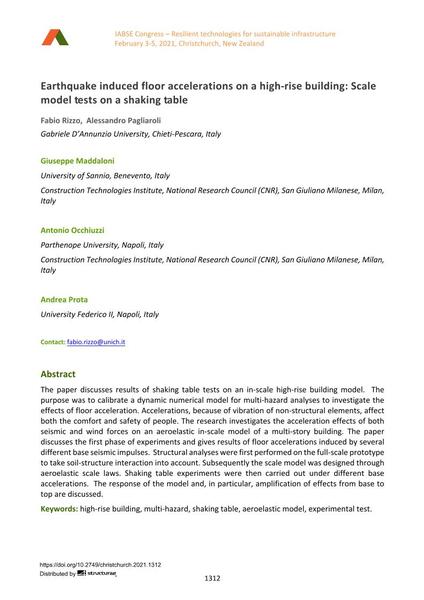Earthquake induced floor accelerations on a high-rise building: Scale model tests on a shaking table

|
|
|||||||||||
Bibliografische Angaben
| Autor(en): |
Fabio Rizzo
(Gabriele D’Annunzio University, Chieti-Pescara, Italy)
Alessandro Pagliaroli (University of Sannio, Benevento, Italy) Giuseppe Maddaloni Antonio Occhiuzzi (Construction Technologies Institute, National Research Council (CNR), San Giuliano Milanese, Milan, Italy) Andrea Prota (University Federico II, Napoli, Italy) |
||||
|---|---|---|---|---|---|
| Medium: | Tagungsbeitrag | ||||
| Sprache(n): | Englisch | ||||
| Tagung: | IABSE Congress: Resilient technologies for sustainable infrastructure, Christchurch, New Zealand, 3-5 February 2021 | ||||
| Veröffentlicht in: | IABSE Congress Christchurch 2020 | ||||
|
|||||
| Seite(n): | 1312-1319 | ||||
| Anzahl der Seiten (im PDF): | 8 | ||||
| DOI: | 10.2749/christchurch.2021.1312 | ||||
| Abstrakt: |
The paper discusses results of shaking table tests on an in-scale high-rise building model. The purpose was to calibrate a dynamic numerical model for multi-hazard analyses to investigate the effects of floor acceleration. Accelerations, because of vibration of non-structural elements, affect both the comfort and safety of people. The research investigates the acceleration effects of both seismic and wind forces on an aeroelastic in-scale model of a multi-story building. The paper discusses the first phase of experiments and gives results of floor accelerations induced by several different base seismic impulses. Structural analyses were first performed on the full-scale prototype to take soil-structure interaction into account. Subsequently the scale model was designed through aeroelastic scale laws. Shaking table experiments were then carried out under different base accelerations. The response of the model and, in particular, amplification of effects from base to top are discussed. |
||||
| Stichwörter: |
Hochhaus
|
||||
